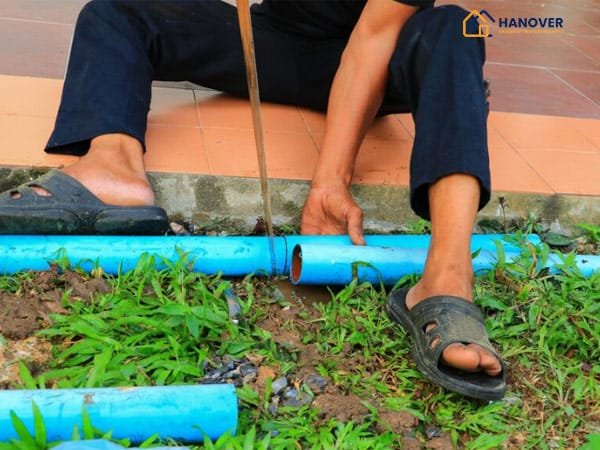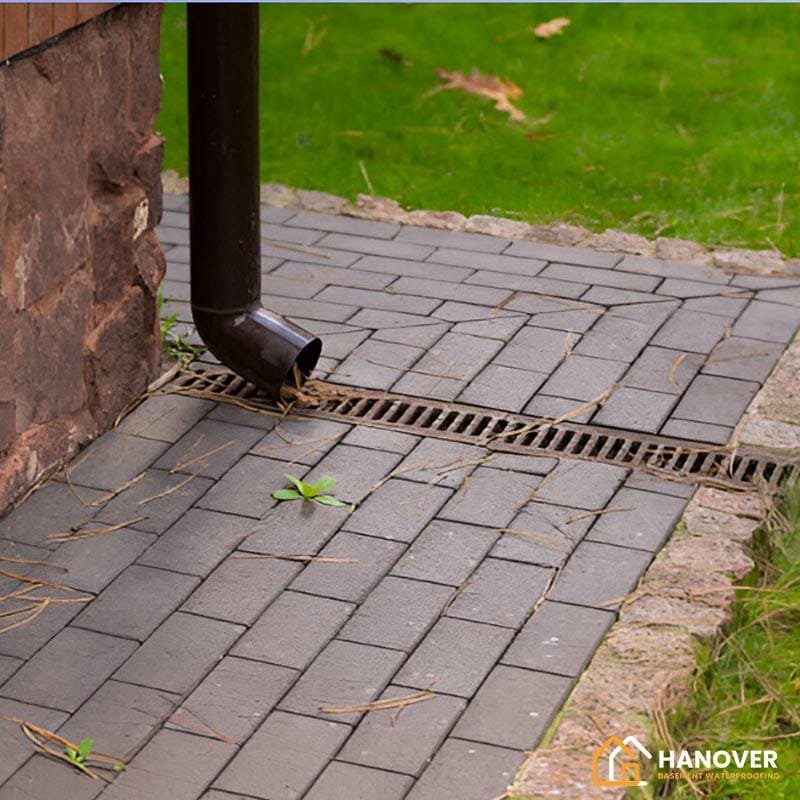Immediate Actions and Critical Areas to Address Drainage Problems
1. Assessing Water Accumulation Patterns
The first step in improving drainage is identifying where water collects. Low-lying areas, foundation perimeters, and landscape depressions are typical zones for standing water. During or immediately after rainfall, inspect your yard for pooling zones and observe how water flows away from your roofline, gutters, and driveway edges. Pay attention to patterns around basement walls, sidewalk seams, and garage thresholds.
A smart move is to mark these areas on a yard sketch and photograph them during peak saturation. This helps establish a drainage behavior baseline. Persistent pooling often indicates larger issues with slope, soil permeability, or blocked outlets.
2. Extending and Redirecting Gutter Downspouts
Gutter downspouts are your home’s first line of defense against water accumulation. If they end near the base of your home, water will naturally collect along the foundation edge, leading to potential basement leaks, mold, or cracks in the concrete. To fix this, use gutter extension pipes or splash blocks to move runoff at least 4 to 6 feet away from the home.
More effective solutions include installing underground drain pipes that channel water to a dry well, retention basin, or landscaped swale. Choose flexible piping to adapt to slopes and avoid roots or existing utilities. When possible, direct runoff toward public storm drains or vegetated drainage corridors, where legal and feasible.
For practical products and guides, visit This Old House on Downspouts.
3. Regrading the Yard for Proper Slope
The contour of your yard plays a crucial role in drainage efficiency. Your soil should slope at least 6 inches within the first 10 feet away from the house. This prevents water from lingering near the foundation base. Many older homes, particularly in regions like Hanover, PA, suffer from settled soil or incorrect backfill angles which reverse the desired slope.
Use a measuring level, landscaping rake, and compatible topsoil to reshape the ground. Always slope away from the home in every direction. For tight areas or complicated terrain, consult a landscaping contractor who specializes in drainage regrading. In cases where structural landscaping changes are needed, you may also consider installing retaining walls to redirect runoff paths.
Learn more strategies in our full guide on how to improve drainage around your home in Hanover.
4. Installing a French Drain System
A French drain is a popular solution for redirecting water across flat or saturated areas. It consists of a perforated pipe, gravel bed, and landscape fabric that together create an underground channel for water to travel toward a release point.
To build one, you must:
- Identify the direction of water flow.
- Excavate a trench slightly wider than the pipe diameter.
- Lay landscape fabric to prevent soil infiltration.
- Position the pipe and cover it with washed gravel.
This method is ideal for handling soggy lawns, waterlogged flower beds, or runoff-prone slopes. French drains are highly durable and, when properly installed, require minimal maintenance.
For illustrated steps, visit Bob Vila’s Guide to French Drains.
5. Creating a Rain Garden in Water Collection Zones
Rain gardens are both aesthetic and functional. Positioned in natural depressions, they collect and filter stormwater using deep-rooted native plants, absorbent soils, and mulch layers. These systems slow runoff, encourage percolation, and prevent water from overwhelming hard surfaces.
When planning your rain garden:
- Choose a site at least 10 feet from your home.
- Test for good percolation using a simple bucket test.
- Select plants adapted to Hanover’s climate, such as switchgrass, blue flag iris, or black-eyed Susan.
Rain gardens serve as long-term solutions that enhance curb appeal while boosting ecosystem services like pollination and habitat creation.
Find planting guidelines at Penn State Extension’s Rain Garden Guide.
6. Installing a Sump Pump System in Basements
Basement flooding is a common issue in areas with high groundwater levels or poor surface runoff redirection. A reliable sump pump system is a vital defense. Installed in a sump pit, it collects water through perimeter drains and pumps it away from your home—usually to a storm drain or yard outlet.
When choosing a system, opt for:
- Submersible sump pumps for larger volumes and quieter operation.
- Battery backup systems to maintain operation during power outages.
- Alarm systems that alert you to overflows or malfunctions.
Ensure the discharge pipe is extended at least 10 feet from the home and not directed onto sidewalks or neighbor properties. Regularly test your sump pump—especially before the spring thaw or after heavy rains.
Need expert help? Our professional sump pump installation services in Hanover, PA ensure every component—from pit placement to discharge routing—is done right the first time.
For product ratings and DIY tips, visit Consumer Reports’ Guide to Sump Pumps.
7. Aerating and Amending Compacted Soil
Compacted soil inhibits water absorption and increases surface runoff. Lawns with heavy foot traffic, clay-heavy compositions, or post-construction settlement often develop this issue. To improve infiltration:
- Perform core aeration in spring or fall to break up dense layers.
- Mix in organic compost, sand, or gypsum to increase porosity.
- Maintain a consistent mulch layer in garden beds to prevent surface sealing.
These steps enhance the soil’s ability to absorb and redistribute moisture. Aeration also encourages root development and improves turf health, both of which help reduce erosion and puddling in low-lying zones.
See expert aeration advice at University of Maryland Extension.

8. Cleaning and Maintaining Surface Drainage Features
Surface drains, including yard basins, curb inlets, and gravel swales, play a key role in capturing and redirecting water during storms. These systems often clog with debris, especially in wooded or leafy neighborhoods like parts of Hanover.
To ensure smooth operation:
- Clean grates and entry points monthly during the rainy season.
- Flush out debris and accumulated sediment with a hose or leaf blower.
- Inspect for signs of corrosion, displacement, or overflows.
Install gravel filters or debris traps where feasible to reduce clogging. Regular maintenance not only prevents backups but also prolongs the life of your landscape infrastructure.
For long-term reliability, consult your municipality for recommendations on materials compatible with Hanover’s climate and runoff conditions.
9. Implementing Seasonal Drainage Adjustments
Seasonal changes bring shifts in drainage needs. In spring, melting snow and increased rain can overwhelm previously dry systems. In fall, leaves can block critical runoff routes. Tailoring your maintenance calendar ensures your drainage remains responsive.
Tips include:
- In spring, inspect for winter damage to drainage lines and check sump pumps.
- In summer, evaluate irrigation schedules to prevent oversaturation.
- In fall, install leaf guards on gutters and remove fallen debris from storm drains.
- In winter, ensure surface grading directs meltwater away before freezing.
By integrating climate-aware practices, you protect both structural foundations and lawn features year-round.
10. Installing a Dry Well for Roof Runoff Storage
A dry well is an underground structure that temporarily stores stormwater before slowly releasing it into the surrounding soil. It’s particularly useful when downspout extensions or French drains are limited by lot size or municipal zoning limits.
Dry wells can be:
- Prefabricated chambers made of plastic or concrete.
- Rock-filled pits wrapped in filter fabric.
- Integrated with gutter systems to manage roof runoff.
When designing a dry well:
- Position it at least 10 feet from foundations.
- Use filter fabric to prevent sediment clogging.
- Ensure the soil type allows infiltration; avoid installing in dense clay zones.
Permits may be required in certain Hanover boroughs. Always check with local building authorities.
11. Improving Driveway and Hardscape Drainage
Impermeable surfaces like driveways, patios, and walkways generate significant runoff during storms. Without proper grading, this runoff can travel directly to home foundations or neighboring properties. To manage water from these surfaces:
- Install trench drains or channel grates across driveway entries.
- Regrade paved areas to encourage lateral flow away from structures.
- Replace or retrofit hardscapes with permeable pavers, interlocking bricks, or porous asphalt that allow water infiltration.
These features not only control water but also reduce heat reflection and improve the aesthetic appeal of your property.
For installation guides, see Interlocking Concrete Pavement Institute’s permeable design resources.
12. Leveraging Swales and Natural Water Pathways
Swales are shallow, sloped depressions designed to carry water away from structures. These can be natural or engineered, and they function best when lined with grass, river rock, or erosion-resistant groundcover. A well-designed swale collects runoff during storms and guides it toward a safe discharge area, like a rain garden or dry well.
Steps to implement:
- Dig along the natural water flow line.
- Ensure a gentle slope of 2–4%.
- Add vegetation to reduce erosion and improve absorption.
Swales are low-maintenance, cost-effective, and highly adaptable to varying landscapes, including sloped yards in Hanover neighborhoods.
For slope guidelines, visit NRCS Swale Construction Guidance.
13. Hanover’s Drainage Codes and Regional Requirements
Residents in Hanover, PA, should always align drainage improvements with local zoning codes, stormwater regulations, and erosion control guidelines. Unpermitted systems or improper installations can result in fines or forced removals.
Common compliance considerations include:
- Distance from property lines for discharge points.
- Connection restrictions to public storm sewers.
- Required setbacks for dry wells and sump pump lines.
- Minimum slope grades for water redirection near structures.
Homeowners are advised to consult the Hanover Borough Code Enforcement Office before initiating any excavation or drainage redirection project. Local requirements may also impact the types of materials or installation practices allowed.
Visit Hanover Borough’s Official Website for permit forms and drainage system guidelines.
Final Thoughts
Improving drainage around your home is not just about eliminating puddles—it’s about protecting your foundation, landscape investment, and property value. From small fixes like downspout extensions to more complex interventions like swales or dry wells, each strategy plays a role in crafting a comprehensive water management plan. Tailor your approach to your yard’s layout, soil type, and regional weather conditions, and always check local regulations to stay compliant and safe.
FAQs
How often should I check my home’s drainage system?
I recommend checking your drainage system at least twice yearly—before and after the rainy season. If there’s heavy rainfall, it’s a good idea to do a quick inspection.
What’s the easiest way to improve drainage around my home?
Start by cleaning your gutters and extending your downspouts to direct water away from your foundation. These simple steps can make a big difference.
Can poor drainage affect my home’s foundation?
Poor drainage can cause water to pool around your foundation, leading to cracks and long-term damage. It’s essential to address any drainage issues early.
How do I know if my drainage system is working correctly?
If you see water pooling near your home after rain or notice cracks in your foundation, it’s a sign that your drainage system needs attention. Also, keep an eye out for musty odors indoors.
Should I hire a professional for drainage improvements?
Suppose you’re dealing with complex issues like a French drain installation or major grading work. In that case, it’s a good idea to call a professional. They can ensure everything is set up correctly, saving you time and stress.

